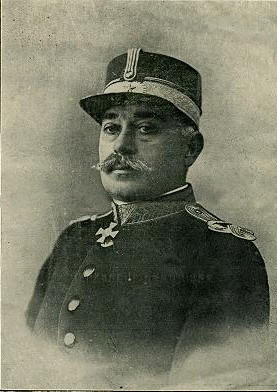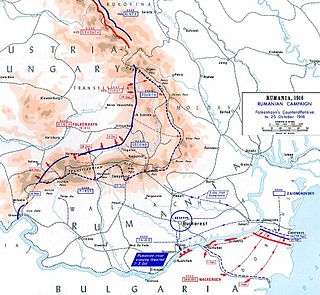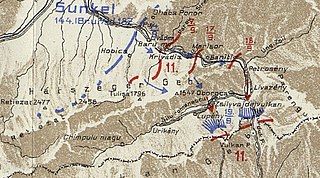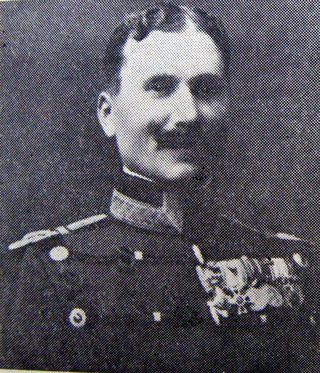
Ioan Dragalina was a Romanian general, who died during the World War I in the First Battle of the Jiu Valley. Dragalina was born in the city of Karansebesch, which at the time was part of the Austrian Empire.

The Battle of Prunaru was a military engagement between German and Romanian forces during the Romanian Campaign of World War I. It resulted in a tactical German victory, but following the heavy Romanian resistance the Germans halted after taking Prunaru. General Constantin Prezan's maneuver group checked the German forces in the region within two days, exposing the left flank of Field Marshal August von Mackensen's Danube Army.

Eremia Teofil Grigorescu was a Romanian artillery general during World War I, and Minister of War in the Constantin Coandă cabinet.

Valea Mare-Pravăț is a commune in Argeș County, Muntenia, Romania. It is composed of eight villages: Bilcești, Colnic, Fântânea, Gura Pravăț, Nămăești, Pietroasa, Șelari, and Valea Mare-Pravăț.

The Battle of Bucharest, also known as the Argeş–Neajlov Defensive Operation in Romania, was the last battle of the Romanian Campaign of 1916 in World War I, in which the Central Powers' combatants, led by General Erich von Falkenhayn, occupied the Romanian capital and forced the Romanian Government, as well as the remnants of the Romanian Army to retreat to Moldavia and re-establish its capital at Iaşi.

Constantin Kirițescu was a Romanian zoologist, educator and historian. Born and schooled in Bucharest, he occupied successive posts in the Education Ministry, with education being a running theme of his diverse interests. He was among the founders of the Romanian Academy of Sciences.

Ioan Culcer was a Wallachian-born Romanian military leader and politician. Culcer served as a lieutenant during the Romanian War of Independence (1877–1878) and as a general during the Second Balkan War and World War I. In early 1918, he served as Minister for Public Works in the First Averescu cabinet.

Ioan Popovici was a Romanian general and commander of the Romanian 1st Army Corps from 1916 to 1918, during World War I.

After a series of quick tactical victories on the numerically overpowered Austro-Hungarian forces in Transylvania, in the autumn of 1916, the Romanian Army suffered a series of devastating defeats, which forced the Romanian military and administration to withdraw to Western Moldavia, allowing the Central Powers to occupy two thirds of the national territory, including the state capital, Bucharest.
The foreign policy of Romania in the years preceding the outbreak of World War I was characterized by the nation's need to contend with the rise and shifting rivalries of the Great Powers of the pre-war era. Its primary objectives were to maintain its territorial integrity and maintain friendly relations with neighboring nations. This culminated in Romania secretly joining the Triple Alliance in 1883. However, the nation would later reverse course, declaring neutrality for the first two years of the war before entering on the side of the Triple Entente in 1916.

The First Battle of the Jiu Valley was a military engagement during World War I fought between Romanian forces on one side and Central Powers forces on the other. The German offensive, although initially successful, was checked within days and subsequently repulsed by a Romanian counterattack. This was the most conspicuous Romanian victory during the 1916 campaign, given that it was achieved against forces which were superior in artillery and - initially - in numbers as well.
The Battle of Báránykút was a military engagement during the Battle of Transylvania, at the beginning of the Romanian Campaign of World War I. It consisted in a German offensive that was successfully repulsed by the Romanians, who then carried out a largely unhindered tactical retreat.

The Battle of Sălătrucu was a military engagement during the Romanian Campaign of World War I. It took place after the Battle of Transylvania and resulted in a Romanian victory. A mixed Central Powers force – under German leadership but with mostly Austro-Hungarian troops – conducted a failed offensive into Romanian territory, south of the Turnu Roșu Pass.

The Battle of the Southern Carpathians was a major operation during the Romanian Campaign of World War I. The brainchild of German General Erich von Falkenhayn, the operation consisted in an attempt by the Central Powers to assault all of the passes in the Southern Carpathians at the same time, and exploit a success wherever it might have come. However, this did not happen, as Romanian defenses could not be defeated in any of the five areas that Falkenhayn's spread-out army tried to force.

The Pitești–Târgoviște Retreat was a fighting-withdrawal operation carried out by the Romanian 1st Army in the face of advancing Central Powers' forces during World War I. The retreat lasted from 29 November to 3 December and culminated in a violent battle at Târgoviște, after which the entire Romanian Army started a general retreat towards Moldavia.

The Battle of Brassó was the last major military engagement during the Battle of Transylvania. It took place between 7 and 9 October 1916, between Central Powers forces on one side and Romanian forces on the other side. As Brassó was the second largest city in Transylvania and the largest Transylvanian settlement taken by the Romanians during their August-September offensive in the region, the retreating Romanian forces decided to make a stand there. However, when its defense proved untenable, the Romanian 2nd Army withdrew from the city, leaving behind only 1,175 prisoners. As the Romanians failed to defend Brassó, so did the Central Powers fail to cut off their escape route, enabling the Romanians to regroup and — under better leadership — thwart the German and Austro-Hungarian attempts to break through the mountains in the region throughout the following month.

The Battle of the Eastern Carpathians consisted in a series of military engagements between Romanian and Austro-Hungarian forces during October 1916, in World War I. The attempt of the Austro-Hungarian 1st Army to break through the Eastern Carpathians was simultaneous with that of the German 9th Army to force the passes of the Southern Carpathians. Both efforts failed.

The Battle of Mezőlivádia was a military engagement fought between Romanian and Central Powers forces during the Romanian Campaign of the First World War. It was part of the Battle of Transylvania. This battle is notable for being the first Central Powers counterattack against the Romanian invasion of Transylvania, as well as the first military engagement during the Battle of Transylvania to involve German forces. The battle resulted in a Romanian victory.

David Praporgescu was a Romanian brigadier general during World War I, who was killed in action at the start of the Battle of the Southern Carpathians.

The Battle of Nagyszeben was a World War I military engagement fought between the forces of the Central Powers on one side and the forces of Romania on the other side. It was the decisive engagement during the Battle of Transylvania, and also the largest, involving four armies out of the five fighting in the region: two Romanian, one German, and one Austro-Hungarian.





















